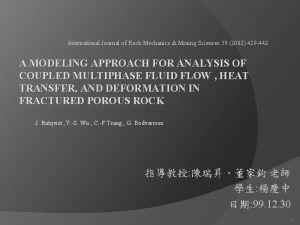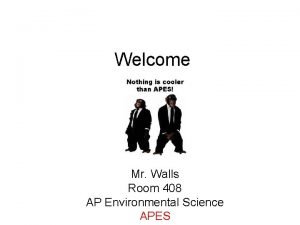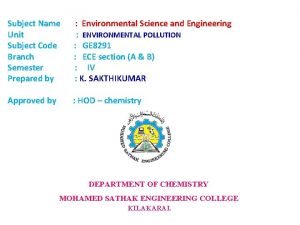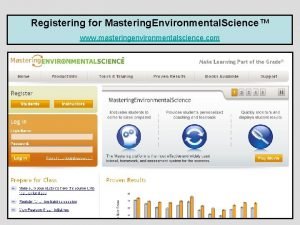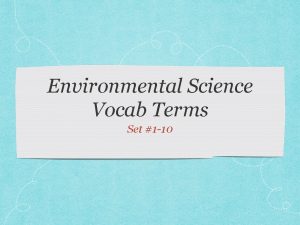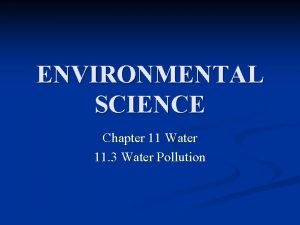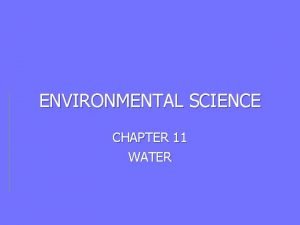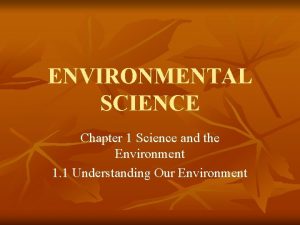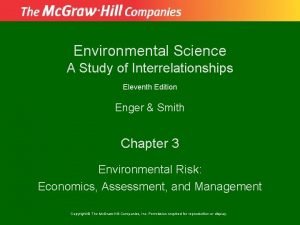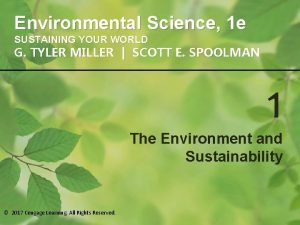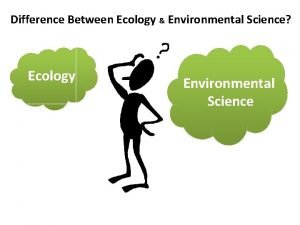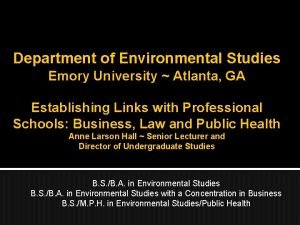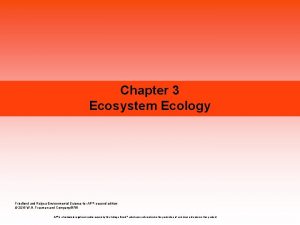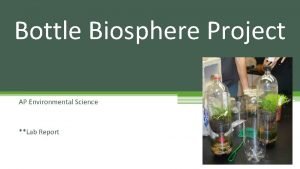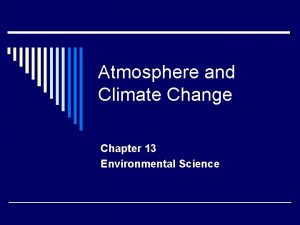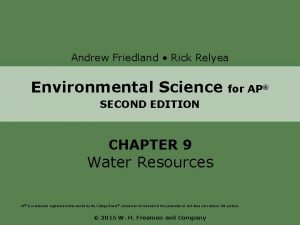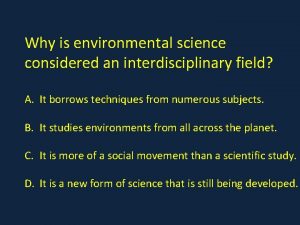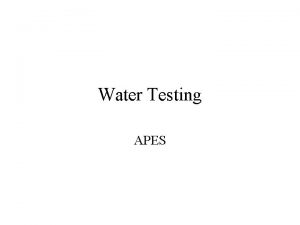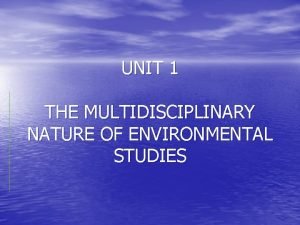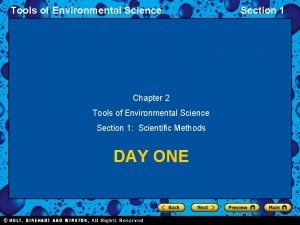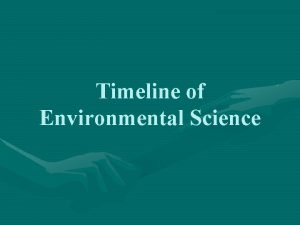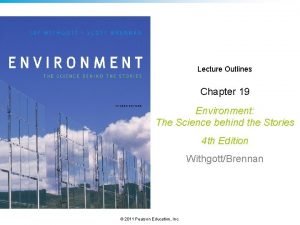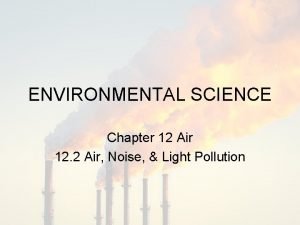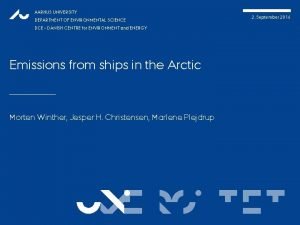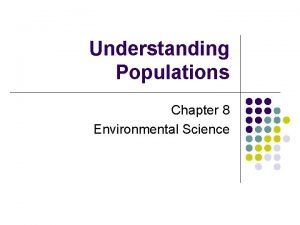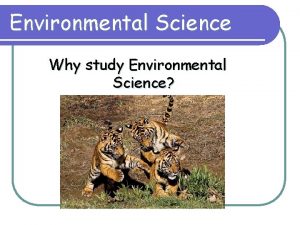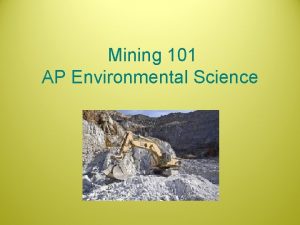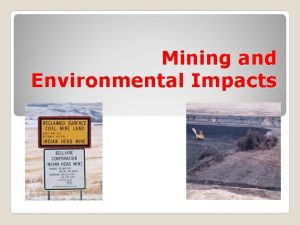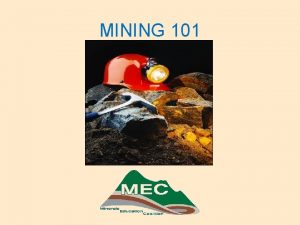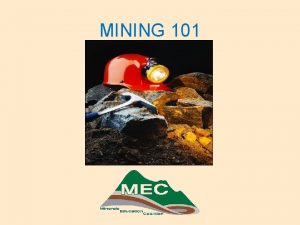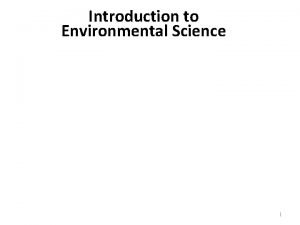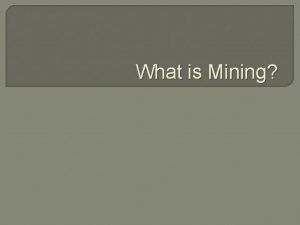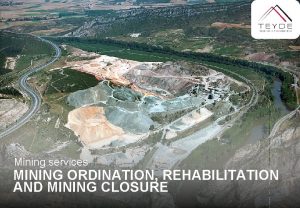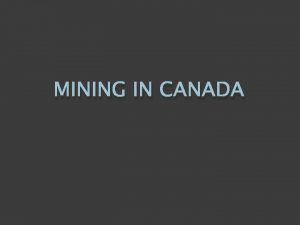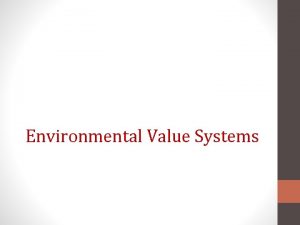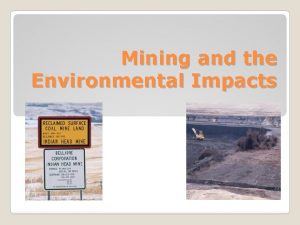Mining 101 AP Environmental Science The Principles of










































- Slides: 42

Mining 101 AP Environmental Science

The Principles of Mining • Mining is the extraction of valuable minerals or other geological materials from the earth from an orebody, lode, vein, seam, or reef, which forms the mineralized package of economic interest to the miner.

Mining • Mining is required to obtain any material that cannot be grown through agricultural processes, or created artificially in a laboratory or factory. • Mining in a wider sense includes extraction of any non-renewable resource such as petroleum, natural gas, or even water.

Land Claim • A MINING Land Claim is a parcel of land for which the claimant has asserted a right of possession and the right to develop and extract a discovered, valuable, mineral deposit. • There are three basic types of minerals on federally-administered lands: locatable, leasable, and salable. Mining claims are staked on locatable minerals on public domain lands.

Locatable, Salable and Leasable • Locatable minerals include gold, silver, copper and other hard rock minerals. (purchased or acquired land - General Mining Law of 1872 • Salable minerals, such as sand, gravel, stone and clay require a contract or permit to mine • Leasable minerals include oil and gas, oil shale, geothermal resources, potash, sodium, native asphalt, solid and semisolid bitumen, bituminous rock, phosphate, and coal.

Economic mineralogy • Study of minerals heavily used in manufacturing. • Important part of domestic & international commerce • Mostly metal ores • Some non-metallics are: graphite, quartz, diamonds.

Metal Resources Metal Uses Millions Metric Tons Annually Iron Heavy machinery, steel production 740 Aluminum Packaging foods & beverages, transportation, electronics 40 Manganese High-strength, high-resistant steel alloys 22. 4 Copper Building construction, electric/electroni industry 8 Chromium High strength steel alloy 8 Nickel Chemical industry, steel alloys 0. 4 Leaded gasoline, car batteries, paint, ammunition Silver Photography, electronics, jewelry Gold Medical, aerospace, electronic use, money, jewelry Platinum Automobile catalytic converters, electronics, medical uses, jewelry-

Metal Resources Biggest Users of Metals • United States • Japan • Europe Biggest Producers • South America • South Africa • Russia

Blood Diamonds • Blood diamonds (also called a conflict diamonds, converted diamonds, hot diamonds, or war diamonds) is a term used for a diamond mined in a war zone and sold to finance an insurgency, an invading army's war efforts, or a warlord's activity. • Diamonds mined during the recent civil wars in Angola, Ivory Coast, Sierra Leone, and other nations have been given the label.

Non-Metal Resources • Sand & gravel (highest volume & dollar value than any other non-metal & greater volume than metals) – Uses: brick & concrete construction, paving, road filler, sandblasting, glass (high silica content sand) • Limestone – Uses: concrete, road rock, building stone, pulverized to neutralize acidic soil or water. • Evaporites- halite, gypsum, potash – Uses: halite- rock salt for roads, refined into table salt – Gypsum- makes plaster wallboard – Potash- for fertilizer (potassium chloride, potassium sulfates) • Sulfur deposits – Uses: sulfuric acid in batteries & some medicinal products

Strategic Metals & Minerals • We depend on about 80 metals & minerals • 18 of these are considered rare & in short supply – EX: Tin, platinum, gold, silver, & lead • Some are strategic resources- we use but cannot produce ourselves.

Strategic Metals & Minerals • If foreign politics, government are unstable, could cut off supplies, causing a crippling of economy or military strength • We stockpile when resource is cheap & available “just in case. ” • EX: bauxite (ore containing aluminum), manganese, chromium, tin, cobalt, tantalum, palladium, platinum • Many LDC sell their strategic resources to make money for country. – Zambia- 50% of national incomes from cobalt exports.

Steps in Obtaining Mineral Commodities • Prospecting- finding places where ores occur • Mine exploration & development- learn whether ore can be extracted economically • Mining- extract ore from ground • Beneficiation- separate ore minerals from other mined rock • Smelting & refining- extract pure mineral from ore mineral (get the good stuff out of waste rock) • Transportation- carry mineral to market • Marketing & sales- find buyers & sell the mineral

Types of Mining • Surface- scoop ore off surface of the earth or dig big holes and scoop – Cheap – Safe for miners – Large amount of environmental destruction • Subsurface- use shafts to reach deeply buried ores – Expensive – Hazardous for miners – Less environmental damage

Types of Surface Mining 1. Open Pit Mining a. Overlaying material is removed using large equipment b. Creates pits that are hundreds of meters wide and hundreds of meters deep.

Types of Surface Mining 2. Strip mining – Like open pit but not as deep of a pit – Same environmental damage

Large bucket wheel extractor being moved through Germany. Moves 10 meters per minute. Takes 5 people to operate. Used in strip mining

Types of Subsurface mining • Coal Shaft, Slope and Drift mining • In situ mining – for radioactive Uranium • Hydraulic Fracturing- fracking

Types of Subsurface Mining • Dredging – Sand is removed from bottom of ocean – Can be done to restore beaches (after hurricane) – Destroys fragile benthic ecosystems

Subsurface Fracturing • Fracking refers to the procedure of creating fractures in rocks and rock formations by injecting fluid into cracks to force them further open. The larger fissures allow more oil and gas to flow out of the formation and into the wellbore, from where it can be extracted. • Hydraulic Fracturing/Fracking

Subsurface Mine Structures • Mine adit- is an entrance to an underground mine which is horizontal or nearly horizontal. A mine adit serves as an entrance, a portal to drain water and for tunnel ventilation. ]

Subsurface Mining: Shaft, Slope and Drift Mining

Mine Shafts and Winzes • Shaft mining refers to the method of excavating a vertical or near-vertical tunnel from the top down with no bottom access. . When the top of the excavation is the ground surface, it is referred to as a shaft; when the top of the excavation is underground, it is called a winze or a subshaft.

Drift Mining and Slope Mining • Drift mining utilizes horizontal access tunnels, slope mining uses diagonally sloping access shafts. • Drift Mining Slope Mining

Mining Issues Mine Safety: In U. S. , stringent mining regulations have lead to a reduction in fatalities, both in terms of total deaths per year, deaths person-hour worked, and deaths per ton mined. surface

Health Problems • mine collapse • fire (methane, coal dust, etc. ). • asphyxiation (methane, carbon monoxide) • pneumoconiosis (from inhaling coal dust) • asbestosis (from inhaling asbestos fibers) • silicosis (from inhaling silicate dust) • heavy metal poisoning (e. g. mercury) • radiation exposure (in uranium mining)

Black Lung/ CWP • Black lung disease is a common name for any lung disease that develops from inhaling coal dust. This name comes from the fact that those with the disease have lungs that look black instead of pink. Medically, it is a type of pneumoconioss called coal workers' pneumoconiosis (CWP).

MSHA • Mine Safety and Health Administration (MSHA) is an agency of the United States Department of Labor which administers the provisions of the Federal Mine Safety and Health Act of 1977 (Mine Act) to enforce compliance with mandatory safety and health standards, eliminate fatal accidents, reduce the frequency and severity of nonfatal accidents, minimize health hazards, and to promote improved safety and health conditions in the nation's mines. [

Environmental Damage • • • Gaping holes in ground (old open pit mines) Tailings and Spoil Banks- cause Acid Mine Drainage Accidental draining of rivers and lakes Disruption of ground water flow patterns Loss of topsoil in strip-mined regions (350 to 2, 700 km 2 in US alone) • Contamination from sulfuric acid (H 2 SO 4) produced through weathering of iron sulfide (Fe. S 2, pyrite) in tailings. – 4 Fe. S 2 + 14 H 2 O = 4 Fe(OH)3 + 8 H 2 SO 4 • Water leaking into mine shafts, washes dissolved metals & toxic material into water sources. – (550, 000 abandoned mines in U. S. - 12, 000 mi of rivers & streams contaminated with mine drainage- cost to clean up $32 -$72 billion)

Lake Peigneur, Louisiana • Lake Peigneur WAS a freshwater lake then on November 20, 1980, a Texaco oil rig accidentally drilled into the Diamond Crystal Salt Company salt mine under the lake. It created a giant hole that resulted in a whirlpool which sucked in the drilling platform, eleven barges, many trees and 65 acres (260, 000 m 2) of the surrounding terrain and the entire Lake Peigneur. Oops.


Mine Tailings (Waste) • Tailings, also called mine dumps, culm dumps, slimes, tails, refuse, leach residue or slickens, • Tailing are the materials left over after the process of separating the valuable fraction from the uneconomic fraction (gangue) of an ore. • Tailing waste contaminates the soil and water with leaching of heavy metals (e. g. arsenic, mercury)

Coeur D' Alene Mine in Colorado “Gangue”- mine tailings

Acid Mine Drainage The impact of mine drainage on a lake after receiving effluent from an abandoned tailings impoundment for over 50 years

Relatively fresh tailings in an impoundment. http: //www. earth. uwaterloo. ca/services/whaton/s 06_amd. html The same tailings impoundment after 7 years of sulfide oxidation. The white spots in Figures A and B are gulls.

Shoreline of a pond receiving AMD showing massive accumulation of iron hydroxides on the pond bottom

Spoil Banks • Spoil banks are where holes were filled in with waste- cheap & easy- susceptible to erosion, chemical weathering, causes high sediment runoff in watersheds. Steep slopes are slow to re-vegetate (succession happens slowly- no topsoil)

Mine effluent discharging from the bottom of a waste rock pile (gangue)

Surface Mining Control & Reclamation Act (SMCRA) • 1977 • Requires better restoration of strip-mined lands • Restoration is difficult & expensive • Takes long time for soil to regain fertility – Topsoil gets buried – Compacted, poor drainage – Root growth restricted • Minimum cost- $1000 per


Georgia vs. Ducktown, TN (1915) • • • In 1800’s began mining copper in Ducktown, TN Built huge open air wood fires by cutting down trees in area. Burned ore to release copper Damage caused: – Clouds of sulfur dioxide released from burning sulfide ore poisoned plants & acidified soil. – Massive interstate air pollution – Rain caused massive erosion – Siltation of reservoirs on Ocoee River impaired electricity generation by the Tennessee Valley Authority (TVA) • • In 1930’s clean up began- spend $250, 000 per year for clean up Trees still spindly, but only 4% of area is still “denuded” 1940’s Now

US Sulfur Dioxide Emissions
 Tragedy of the commons
Tragedy of the commons Strip mining vs open pit mining
Strip mining vs open pit mining Strip mining vs open pit mining
Strip mining vs open pit mining Difference between strip mining and open pit mining
Difference between strip mining and open pit mining Difference between text mining and web mining
Difference between text mining and web mining Mining multimedia databases in data mining
Mining multimedia databases in data mining Mining complex types of data
Mining complex types of data My favourite subject science
My favourite subject science Wireless health
Wireless health Responsible gold mining principles
Responsible gold mining principles International journal of rock mechanics and mining sciences
International journal of rock mechanics and mining sciences Ap environmental science exam pass rate
Ap environmental science exam pass rate Tragedy of the commons environmental science
Tragedy of the commons environmental science Ge8291 subject name
Ge8291 subject name Environmental science
Environmental science About environmental issues
About environmental issues Environmental science vocab
Environmental science vocab Final exam environmental science
Final exam environmental science Introduction water pollution
Introduction water pollution Environmental science chapter 11
Environmental science chapter 11 Environmental science chapter
Environmental science chapter Tragedy of the commons environmental science
Tragedy of the commons environmental science Environmental science sustaining your world
Environmental science sustaining your world Difference between environmental science and ecology
Difference between environmental science and ecology Emory environmental science
Emory environmental science Npp environmental science
Npp environmental science Bottle biosphere guide
Bottle biosphere guide Chapter 13 environmental science
Chapter 13 environmental science Ap environmental science jeopardy
Ap environmental science jeopardy Friedland and relyea environmental science
Friedland and relyea environmental science A science is considered interdisciplinary when weegy
A science is considered interdisciplinary when weegy Turbidity apes
Turbidity apes Multidisciplinary nature of environmental studies;
Multidisciplinary nature of environmental studies; Chapter 2 tools of environmental science
Chapter 2 tools of environmental science Environmental science timeline
Environmental science timeline National 5 environmental science
National 5 environmental science Environmental chemistry science olympiad
Environmental chemistry science olympiad Chapter 19 environmental science
Chapter 19 environmental science Environmental science chapter 2
Environmental science chapter 2 Radonrid
Radonrid Environmental science
Environmental science Chapter 8 environmental science
Chapter 8 environmental science Tools of environmental science
Tools of environmental science










